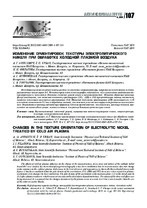| dc.contributor.author | Анисович, А. Г. | |
| dc.contributor.author | Урбан, Т. П. | |
| dc.contributor.author | Филатова, И. И. | |
| dc.contributor.author | Буйницкая, А. С. | |
| dc.contributor.author | Гончарик, С. В. | |
| dc.coverage.spatial | Минск | ru |
| dc.date.accessioned | 2020-01-17T12:33:45Z | |
| dc.date.available | 2020-01-17T12:33:45Z | |
| dc.date.issued | 2019 | |
| dc.identifier.citation | Изменение ориентировок текстуры электролитического никеля при обработке холодной плазмой воздуха = Changes in the texture orientation of electrolytic nickel treatied by cold air plasma / А. Г. Анисович [и др.] // Литье и металлургия. – 2019. – № 4. – С. 107-114. | ru |
| dc.identifier.uri | https://rep.bntu.by/handle/data/62812 | |
| dc.description.abstract | Исследовано влияние холодной плазмы воздуха на изменение микроструктуры, напряженного состояния и текстуры катодного никеля марки Н-1. Методом прицельной металлографии установлено, что в результате воздействия ми- кроструктура не изменяется. Показано снижение уровня микро- и макронапряжений. Методом обратных полюсных фигур установлено, что полюсная плотность ориентировок (111), (200) и (311) при воздействии плазмы снижается; наименее интенсивно изменяется ориентировка (311). Полюсная плотность ориентировки (220) увеличивается с 4,42 в исходном состоянии до 13,3 после обработки плазмой, что означает усиление текстуры электролитического осаждения. Обсуждаются причины наблюдаемых эффектов. Сделано предположение, что изменения, вносимые плазмой, происходят на масштабном уровне, намного меньшем, чем размер блоков когерентного рассеяния. | ru |
| dc.language.iso | ru | ru |
| dc.publisher | БНТУ | ru |
| dc.title | Изменение ориентировок текстуры электролитического никеля при обработке холодной плазмой воздуха | ru |
| dc.title.alternative | Changes in the texture orientation of electrolytic nickel treatied by cold air plasma | ru |
| dc.type | Article | ru |
| dc.identifier.doi | 10.21122/1683-6065-2019-4-107-114 | |
| local.description.annotation | The effects of cold air plasma influence on the change in the microstructure, stress state and texture of the cathode nickel brand H-1 were studied. By the method of target metallography it has been established that the microstructure does not change under exposure to the cold air plasma. A decrease in the level of micro- and macrostress is shown. By the method of inverse pole figures it has been established that the pole density of the orientations (111), (200) and (311) decreases when exposed to plasma; orientation (311) changes the least intensively. The pole density of the orientation (220) increases from 4.42 in the initial state to 13.3 after plasma treatment, which means an increase in the electrolytic deposition texture. The causes of the observed effects are being discussed. It is assumed that the changes introduced by the plasma occur at a scale level that is much smaller than the size of the coherent scatter blocks. | ru |

